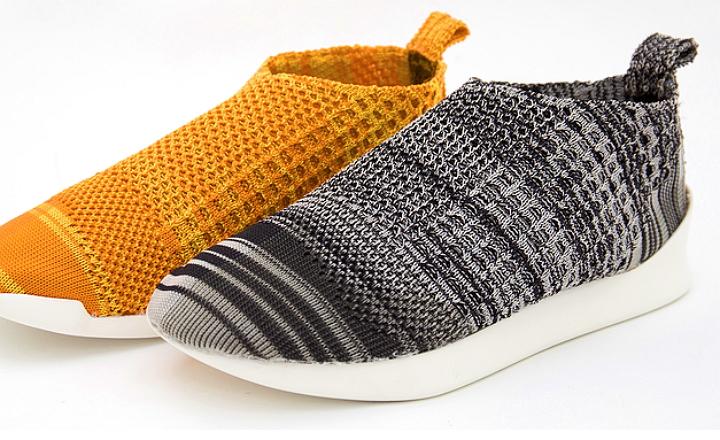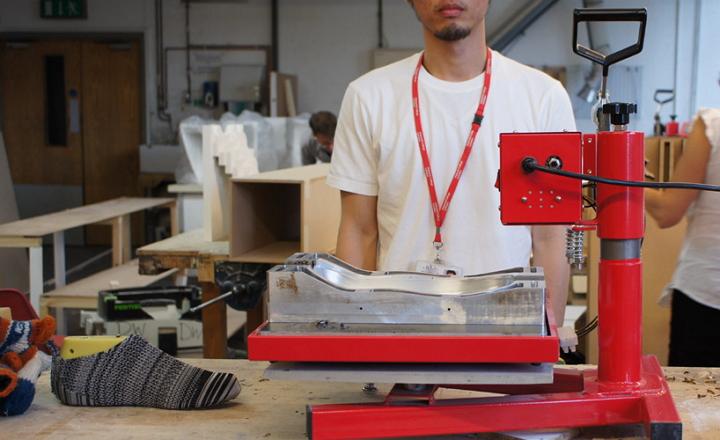 Designer Ammo Liao moved from his home of 28 years in Tainan, Taiwan where the buildings and culture inspired him to develop his design skills, and he took those influences with him when he moved on to the UK to study at the Royal College of Art and Imperial College London.
Designer Ammo Liao moved from his home of 28 years in Tainan, Taiwan where the buildings and culture inspired him to develop his design skills, and he took those influences with him when he moved on to the UK to study at the Royal College of Art and Imperial College London.
Liao has, as part of his work and study there, created a shoe which uses no composites but does offer varying levels of softness, strength, and flexibility in a layering process.
He says the BioKnit shoe was inspired by biomimicry principles and is produced by 3D printing textiles and melting them to create the necessary properties within the same textile-like materials.
Biomimicry, an approach to innovation aimed at finding solutions to human challenges by emulating nature and the patterns and strategies found in the natural world, has now become a tool to create products, processes, and policies which are better adapted to the long haul for the planet. At the core of the concept is that nature has already essentially “solved” a wide variety of problems in engineering. Through the study of animals, plants, and microbes, designers are now taking advantage of what has basically been billions of years of research and development.
With some 330 million pairs of shoes sold in the UK each year, the lion’s share of them will ultimately end up in a landfill, and once they’ve been dumped there, experts believe it will take them 50 years to decompose. But recycling those shoe products is a significant problem. In most cases, shoes are created with multi-material processes and may be constructed from a large number of parts via an even larger number of processes.
The BioKnit shoe, Liao says, offers a solution which was designed and produced to demonstrate that using a single material to build a product is not only possible, but desirable.
The process of building these shoes begins with a 3D knitting process where polymer-base yarns are fed into an automated loom capable of creating various patterns in selected sections of the weave to enable flexibility and rigidity in those areas. While the portion of the shoe near the ankle might require more flexibility, the toe, heel, and arch sections require considerably more rigid construction for support.
According to Liao, different colors and patterns can easily be programmed into the loom and thus incorporated into the final weave. The shoes, which are knitted in flat sections, are then sewn together and heat pressed into their 3D printed soles. And prior to final assembly, the heel and toe sections are heat-pressed as well and then laser engraving is used to harden discrete sections with extreme accuracy.
 Liao came up with concept as he was a student in the RCA Innovation Design Engineering course. The project was ultimately presented at the RCA 2015 graduate exhibition next to a project which built a series of stools from waste nylon powder from 3D printing.
Liao came up with concept as he was a student in the RCA Innovation Design Engineering course. The project was ultimately presented at the RCA 2015 graduate exhibition next to a project which built a series of stools from waste nylon powder from 3D printing.
Using what the designer says is “textile biomimicry,” the single material is manipulated to provide multiple functions and simultaneously prove versatile and robust. Liao says creating the product with a single material will dramatically reduce the recycling cost of similar products which require multi-material construction. As additional benefits, he says the process will conserve natural resources and save energy and reduce greenhouse gases and the ensuing pollution.
Do you see a time when products can be made from single, engineered materials and 3D engineering processes to reduce the complexity of the processes? Let us know in the BioKnit forum thread on 3DPB.com.
Subscribe to Our Email Newsletter
Stay up-to-date on all the latest news from the 3D printing industry and receive information and offers from third party vendors.
Print Services
Upload your 3D Models and get them printed quickly and efficiently.
You May Also Like
The Dental Additive Manufacturing Market Could Nearly Double by 2033, According to AM Research
According to an AM Research report from 2024, the medical device industry, specifically in dentistry, prosthetics, and audiology, is expected to see significant growth as these segments continue to benefit from...
Heating Up: 3D Systems’ Scott Green Discusses 3D Printing’s Potential in the Data Center Industry
The relentless rise of NVIDIA, the steadily increasing pledges of major private and public investments in national infrastructure projects around the world, and the general cultural obsession with AI have...
AM Research Webinar Explores Continuum’s Sustainable Metal Additive Manufacturing Powders
Metal additive manufacturing (AM) powder supplier Continuum Powders is working to develop solutions that empower industries to reduce waste and optimize their resources. An independent life cycle assessment (LCA) of...
3D Printed Footwear Startup Koobz Lands $7.2M in Seed Round
California-based Koobz is focused on reshoring the U.S. footwear supply chain with advanced manufacturing processes, including 3D printing. The startup just announced that it has added $6 million to its...
































